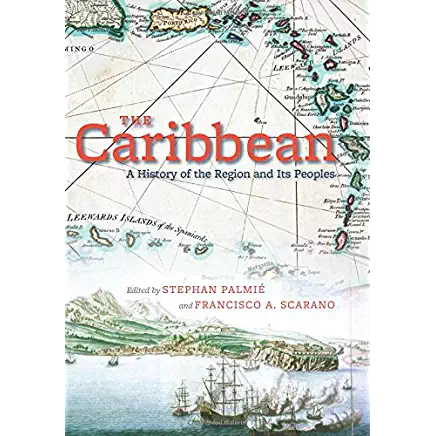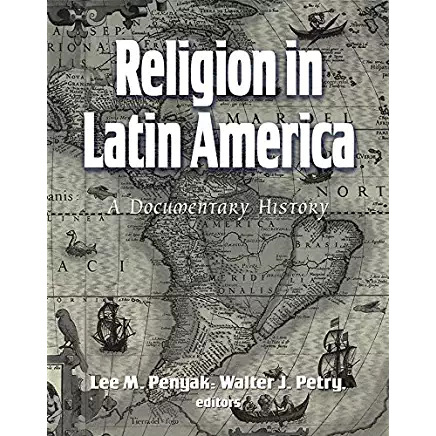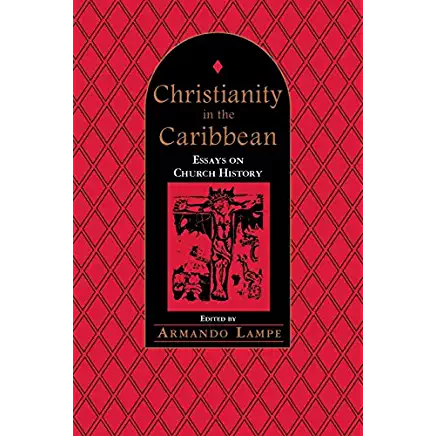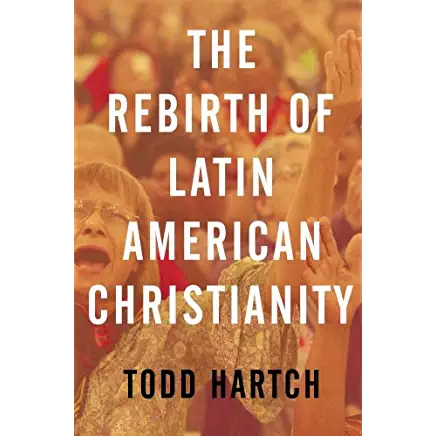Caribbean Initiative Recommended Reading: History and Culture
 |
The Caribbean: A History of the Region and Its Peoples (2011), by Stephan Palmié- “Combining fertile soils, vital trade routes, and a coveted strategic location, the islands and surrounding continental lowlands of the Caribbean were one of Europe’s earliest and most desirable colonial frontiers. The region was colonized over the course of five centuries by a revolving cast of Spanish, Dutch, French, and English forces, who imported first African slaves and later Asian indentured laborers to help realize the economic promise of sugar, coffee, and tobacco. The Caribbean: A History of the Region and Its Peoples offers an authoritative one-volume survey of this complex and fascinating region.”
|
 |
A History of the Caribbean: Plantations, Trade, and Work in the Atlantic World (2007), by Frank Moya Pons- “In this comprehensive volume, Moya Pons explores the history, context, and consequences of the major changes that marked the Caribbean between Columbus’ initial landing and the Great Depression. He investigates indigenous commercial ventures and institutions, the rise of the plantation economy in the 16th century, and the impact of slavery. He discusses the slave revolts and struggles for independence, seen by European landowners not as a matter of human or political rights but as an expensive interruption to their profit flow.”
|
 |
From Columbus to Castro: The History of the Caribbean, 1492-1969 (1984), by Eric Williams- “ There are about 30 million people scattered across an arc of islands — Jamaica, Haiti, Barbados, Antigua, Martinique, Trinidad, among others-separated by the languages and cultures of their colonizers, but joined together, nevertheless, by a common heritage. For whether French, English, Dutch, Spanish, Danish, or-latterly-American, the nationality of their masters has made only a notional difference to the peoples of the Caribbean. The history of the Caribbean is dominated by the history of sugar, which is inseparable from the history of slavery; which was inseparable, until recently, from the systematic degradation of labor in the region. Here, for the first time, is a definitive work about a profoundly important but neglected and misrepresented area of the world.”
|
 |
Empire’s Crossroads: A History of the Caribbean from Columbus to the Present Day (2014), by Carrie Gibson- “British American historian Carrie Gibson traces the story of this coveted area from the northern rim of South America up to Cuba, and from discovery through colonialism to today, offering a vivid, panoramic view of this complex region and its rich, important history.”
|
 |
Talking Taino: Caribbean Natural History from a Native Perspective (2008), by William F. Keegan and Lisabeth A. Carlson- “In an effort to repay their debt to the past and the present, the authors have focused on the relationship between the Taínos of the past (revealed through archaeological investigations) and the present natural history of the islands. Bringing the past to life and highlighting commonalities between past and present, they emphasize Taíno words and beliefs about their worldview and culture.”
|
 |
A Brief History of the Caribbean: From the Arawak and the Carib to the Present (2000), by Jan Rogoziński- “This comprehensive volume takes the reader and student through more than 500 years of Caribbean history, beginning with Columbus’s arrival in the Bahamas in 1492. The superbly written history, revised and updated, with new chapters that reflect the islands’ most recent social, economic, and political developments, is a work of impeccable scholarship. Featuring maps, charts, tables, and photographs, it remains the ideal guide to the region and its people.”
|
 |
The Caribbean Basin (2013), by Graeme Mount and Stephen Randall- “Provides a study of the entire Caribbean region, including Central America and the Caribbean coast of northern South America. It also offers analysis of: the role of international intervention, the complex interaction among major world powers in the area, conflicts over colonial possessions and trade routes, Soviet-American confrontation in the Cold War years. Integrating the recent political, social and economic history of the Caribbean with its miltary and diplomatic past, this book charts the region’s emergence from colonialism during the course of the twentieth century.”
|
 |
Frontiers, Plantations, and Walled Cities: Essays on Society, Culture, and Politics in the Hispanic Caribbean (1800-1945) (2010), by Luis Martínez-Fernández- “In the nineteenth and twentieth centuries, the Hispanic Caribbean was fundamentally a plantation economy dominated mainly by the world sugar market. The politics were shaped by revolutions, political coups, wars, and elections, resulting in an end of Spanish power, independent states, and the domination of the region by the United States. These developments led to changes in social values. The author follows these developments throughout the main Hispanic islands and provides a fascinating picture of a region in turmoil.”
|
 |
An Intellectual History of the Caribbean (2006), by Silvio Torres-Saillant- “The first intellectual history of the Caribbean written by a top Caribbean studies scholar, this book examines both writings penned by natives of the region as well as a body of texts interpretive of the region produced by Western authors.”
|
 |
Sea of Storms (2015), by Stuart B. Schwartz- “Schwartz examines how Caribbean societies have responded to the dangers of hurricanes, and how these destructive storms have influenced the region’s history, from the rise of plantations, to slavery and its abolition, to migrations, racial conflict, and war. Taking readers from the voyages of Columbus to the devastation of Hurricane Katrina, Schwartz looks at the ethical, political, and economic challenges that hurricanes posed to the Caribbean’s indigenous populations and the different European peoples who ventured to the New World to exploit its riches.”
|
 |
Bolívar: American Liberator (2014), by Marie Arana- “Drawing on a wealth of primary documents, Arana vividly captures the early nineteenth-century South America that made Bolívar the man he became: fearless general, brilliant strategist, consummate diplomat, dedicated abolitionist, gifted writer, and flawed politician. A major work of history,Bolívarnot only portrays a dramatic life in all its glory, but is also a stirring declaration of what it means to be South American.”
|
 |
The History of Latin America: Collision of Cultures (2007), by Marshall C. Eakin- “This narrative history of Latin America surveys five centuries in less than five hundred pages. The first third of the book moves from the Americas before Columbus to the wars for independence in the early nineteenth century. The construction of new nations and peoples in the nineteenth century forms the middle third, and the final section analyzes economic development, rising political participation, and the search of identity over the last century. The collision of peoples and cultures–Native Americans, Europeans, Africans–that defines Latin America, and gives it both its unity and diversity, provides the central theme of this concise, synthetic history.”
|
 |
Afro-Caribbean Religions (2009), by Nathaniel Samuel Murrell- “Religion is one of the most important elements of Afro-Caribbean culture linking its people to their African past, from Haitian Voodoo and Cuban Santeria popular religions that have often been demonized in popular culture to Rastafari in Jamaica and Orisha-Shango of Trinidad and Tobago. In Afro-Caribbean Religions, Nathaniel Samuel Murrell provides a comprehensive study that respectfully traces the social, historical, and political contexts of these religions.”
|
 |
Creole Religions of the Caribbean: An Introduction from Vodou and Santeria to Obeah and Espiritismo, Second Edition (2011), by Margarite Fernandez Olmos and Lizabeth Paravisini-Gebert- “Brought together in the crucible of the sugar plantation, Caribbean peoples drew on the variants of Christianity brought by European colonizers, as well as on African religious and healing traditions and the remnants of Amerindian practices, to fashion new systems of belief. Creole Religions of the Caribbean offers a comprehensive introduction to the syncretic religions that have developed in the region.”
|
 |
Religion in Latin America: A Documentary History (2007), ed. Lee M. Penyak and Walter J. Petry- “These carefully selected documents on the religions of Latin America begin with the arrival of Columbus and the existence and shape of indigenous religions at the time. This documentary history of nearly six hundred years includes Catholicism, Protestantism, Pentecostalism, Candomble and Umbanda, Judaism, and the religions indigenous to Latin America.”
|
 |
Christianity in the Caribbean: Essays on Church History (2001), edited by Armando Lampe- “This is a collection of essays on the history of Christianity and the role of the Church in the processes of colonization and decolonization in the Caribbean. They look at the relationships that existed among slavery, colonialism and Catholicism.”
|
 |
Born in Blood and Fire: A Concise History of Latin America (2011), by John Charles Chasteen- “A compelling narrative of the Latin American experience, animated by stories about men and women from all walks of life, and enriched by insightful analysis. The famous and not so famous characters of Latin America are here: Cortes, Malinche, Moctezuma, Sister Juana Ines de la Cruz, Bolivar, Father Manual Hidalgo, Juan and Evita Peron, and, of course, Che Guevara. This is a story of despair and hope, the processes of conquest and colonization, race mixing and class construction, revolution and republic formation, and the elusive quests for sustained economic growth and political and social equality.”
|
 |
Protestantism and Political Conflict in the Nineteenth-Century Hispanic Caribbean (2002), by Luis Martínez-Fernández- “Traces the emergence of Protestantism in Cuba and Puerto Rico during a crucial period of national consolidation. Using a comparative framework, Martinez-Fernandez looks at the ways in which Protestantism, though officially illegal for most of the century, established itself, competed with Catholicism, and took differing paths in Cuba and Puerto Rico. One of the book’s main goals is to trace the links between religion and politics, particularly with regard to early Protestant activities.”
|
 |
Latin American Theology: Roots and Branches (2016), by Maria Clara Bingemer- “Bingemer, a key protagonist in the development of Latin American theology, provides a succinct summary of its history and distinctive elements. She goes on to show how this theology grew and adapted to new challenges, including the issues of gender, the role of indigenous voices, concern for ecology, and dialogue with other religious traditions.”
|
 |
Christianity in Latin America: A History (2008), by Justo L González and Ondina E. González- “Presents the important encounters between people, ideas, and events of this large, heterogeneous subject. This book offers an accessible and engaging review of the history of Christianity in Latin America with a widely ecumenical focus to foster understanding of the various forces shaping both Christianity and the region.”
|
 |
The Rebirth of Latin American Christianity (2014), by Todd Hartch- “Although many Catholics left their church to become Pentecostals, many others responded to the Protestant challenge by joining new Catholic movements. Today, Latin American Christianity is so energized that the region is sending missionaries to Africa, Europe, and the United States. In The Rebirth of Latin American Christianity, Todd Hartch examines the changes that have swept across Latin America in the last fifty years and situates them in the context of the growth of Christianity in the global South.” |
 |
New Worlds: A Religious History of Latin America (2012), by John Lynch- “Book follows the development of religious culture over time by focusing on peak periods of change: the response of religion to the Enlightenment, the emergence of the Church from the wars of independence, the Romanization of Latin American religion as the papacy overtook the Spanish crown in effective control of the Church, the growing challenge of liberalism and the secular state, and in the twentieth century, military dictators’ assaults on human rights.”
|
 |
Global Pentecostal and Charismatic Healing (2011), Candy Gunther Brown- “Pentecostal and Charismatic Christianity is a global phenomenon that comprises a quarter of the world’s two billion Christians and is growing rapidly. This volume reveals that the primary appeal of pentecostalism worldwide is as a religion of healing.”
|
 |
Congotay! Congotay! A Global History of Caribbean Food (2013), by Candice Goucher- “Since 1492, the distinct cultures, peoples, and languages of four continents have met in the Caribbean and intermingled in wave after wave of post-Columbian encounters, with foods and their styles of preparation being among the most consumable of the converging cultural elements. This book traces the pathways of migrants and travelers and the mixing of their cultures in the Caribbean from the Atlantic slave trade to the modern tourism economy.”
|
 |
Pop Culture in Latin America and the Caribbean (2015), by Elizabeth Nichols and Timothy Robbins- “This book explores controversial issues like censorship, gender, cultural imperialism, and globalization, allows for cross-cultural comparisons between Latin America, the Caribbean, and the United States, enables quick access to areas of interest through well-organized entries and helpful topic introductions, and features a discussion on the influence of modern technologies―the Internet, social media, and video games―in Latin American cultures.”
|
